Currently there are 33 identified species of endemic birds in Sri Lanka, out of which most are found in the wet zone. November to April are considered the best months of the year to spot most of these endemics. The Kithulgala and Sinharaja forest reserves in the low lands are amongst the top spots to view a majority of these endemics. Horton Plains National Park in the hills is the best place to catch the endemics that enjoy their life at altitude.
Ceylon Hanging Parrot - Loriculus beryllinus
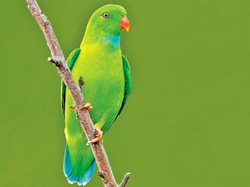
This diminutive and brilliantly coloured parrot occurs everywhere in the hills up to about 1,300 metres it also occurs in low country wet zone. Like other Sri Lankan parakeets, this is a green bird with a short tail. A fairly common small bird occurring in forested areas, home gardens and plantations. Usually lives singly or in pairs and sometimes in small parties. Kandy, Kitulgala and Sinharaja are the best areas to spot this bird.
Ceylon Bush-Warbler - Elaphrornis palliseri
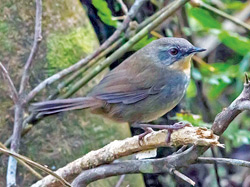
The skulking bird is found only above 1,500 metres in dense undergrowth moving stealthily but occasionally showing itself well. Generally dark with rusty-buff throat, dark grey breast and rounded tail. Faint pale eyebrow and pale eye ring. Olive brown upper parts with a rusty tinge on rump, olive grey belly with rufous tinge on flanks and under tail. Male has red eyes and female pale buff. Nuwara Eliya and Horton plains are the best locations to see this rare bird.
Ceylon Grey Hornbill - Ocyceros gingalensis
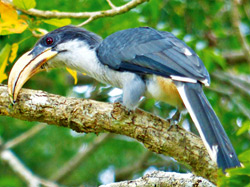
Of the two hornbills occurring in Sri Lanka, this is the smaller one. A locally common bird in all low country forests, well wooded areas and gardens. It occurs in both wet and dry zones and occasionally ascends the hills to about 1300 metres. It lives in pairs or small flocks. Like most hornbills. The female imprisons herself in a tree hole for incubation during the breeding season. Kitulgala is among the best places for one to see this bird.
Ceylon Rufous Babbler - Argya rufesceres
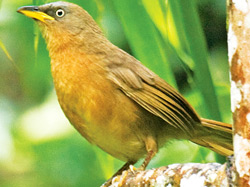
The rufous babbler is distinguishable from other babblers by its rufous coloration and bright orange bill and legs. It can be seen in most of the undisturbed forests in the wet zone and in the hills to highest elevations. Though it is a forest bird it often ventures into will wooded gardens in adjacent areas. Always in small groups busily working their way through the foliage of trees and understory. Another nucleus species of the feeding waves of the Sinharaja forest. A noisy bird that reveals its presence by continuous chattering and squeaking.
Ceylon Swallow - Hirundo hyperythra
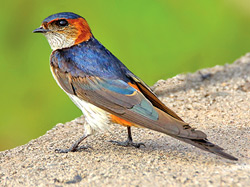
This rather slow flying swallow with reddish chestnut underparts and rump has a deeply forked tail. It looks heavier built than the other swallows in the island. It is found throughout the lowlands and the hills to about 1,300 metres. It prefers open country and can be seen in pairs or small scattered flocks.
Spot-winged Ground-Thrush - Geokichla spiloptera

A very striking thrush with rich olive brown upper parts, two rows of spots on median coverts and a characteristic black and white facial pattern. It is found throughout the low country wet zone and the hills up to about 2,000 metres, a bird of forest and well wooded gardens adjacent to these areas. Its melodious song can be heard at dawn and dusk in Sinharaja, Dombagaskanda and Kitulgala where it could be easily observed along the trails.
Ceylon Scimitar-Babbler - Pomatorhinus melanurus
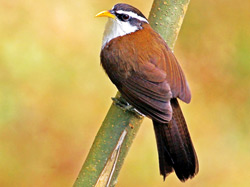
This very vocal and attractive slender babbler has a long yellow down curved bill, long white eyebrow extending onto the nape and a black eye stripe. Upper parts are rusty brown with a dark brown crown, white under parts with brown flanks, vent and under tail coverts. Both sexes alike. However, it is not confined to forests if sufficient cover is available, it will take up residence in estates and well wooded gardens. Lives in pairs or family parties.
Yellow-fronted Barbet - Psilopogon flavifrons

This beautiful barbet is one of the commonest endemic birds of Sri Lanka. Its incessant call is the trademark of the wet zone forest. Though more partial to heavy forests, that likes wooded home gardens. The call is audible over a fair distance. In Sinharaja, it can be seen as a regular member of the mixed feeding flocks. Udawattakele in Kandy is one of its best haunts.
Green-billed Coucal - Centropus chlororchynchos

A slightly smaller coucal than the more common greater coucal from which it can be readily distinguished by its large pale green bill. A rare forest loving bird that inhabits the dense undergrowth of wet zone forests with dwarf bamboo. Does not hesitate to come into home gardens adjacent to these forests, very elusive. Lives in pairs. Kitulgala and Sinharaja are again the best locations.
Red faced Malkoha - Phaenicophaeus pyrrhocephalus

Another forest dweller which has very arboreal habits. Not common by any means. Found mostly in undistributed wet zone forests and in a few of the tall riparian forests of the drier parts. An unmistakable large bird with a crimson red face. Very frequently, a member of mixed species flocks of Sinharaja rain forest. It usually lives in pairs but at times two or three pairs are in these feeding flocks. Sinharaja is the easiest place to observe this bird.
